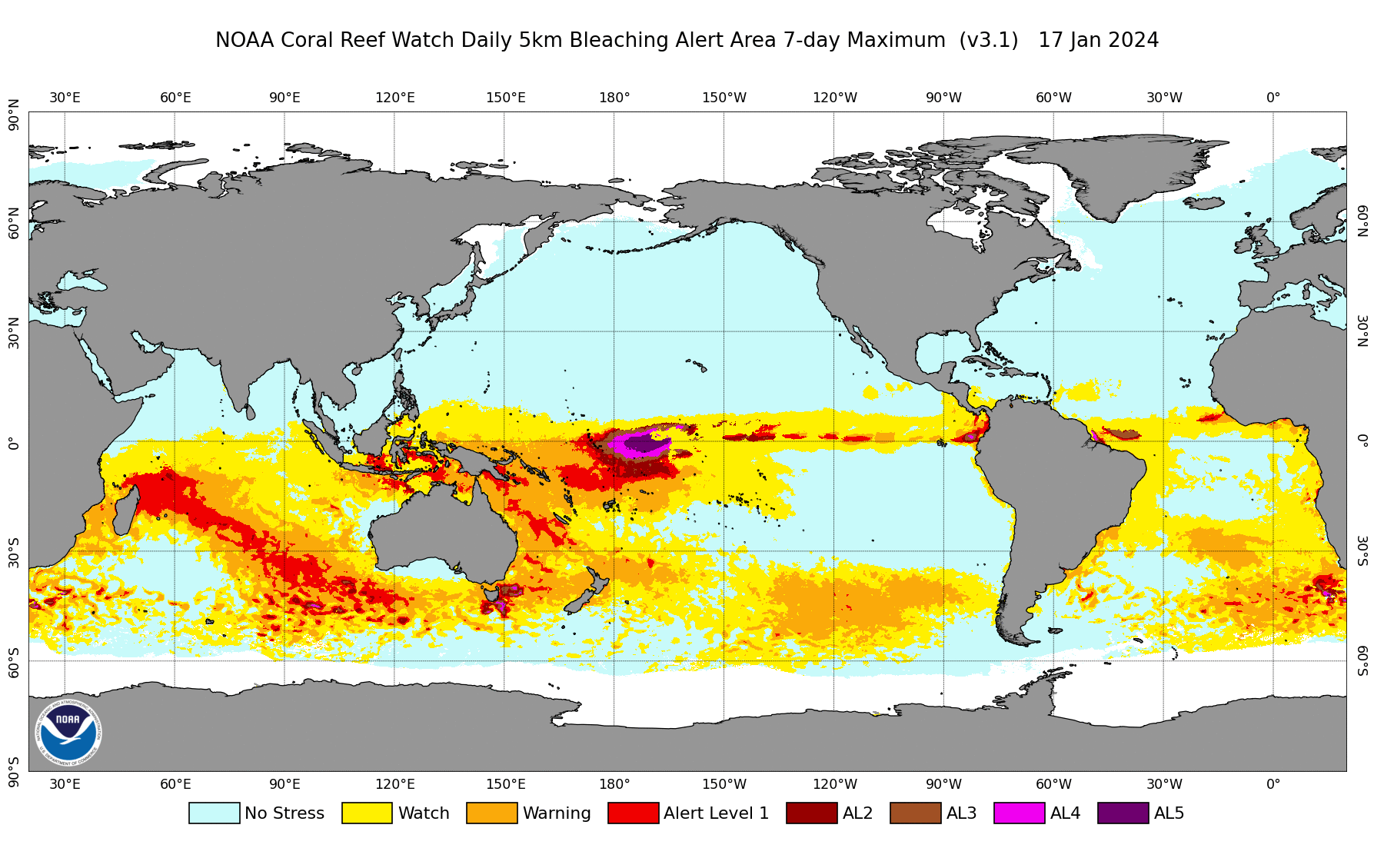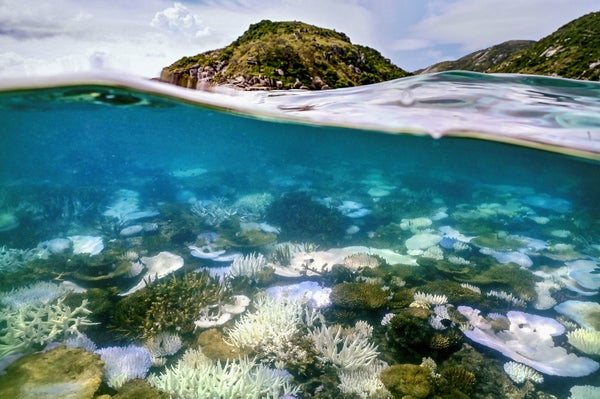Ocean heat is killing corals at such high rates that scientists have declared Earth to be in its fourth global bleaching event—the second in a decade. The announcement comes from a partnership between the U.S. National Oceanic and Atmospheric Administration and the International Coral Reef Initiative.
Despite their plantlike appearance, corals are animals, and their vibrant colors come from microbes that live inside the creatures and offer them a range of services. Some of these so-called symbionts produce sugars through photosynthesis, some provide other nutrients for the corals, and some protect their health. But when corals are stressed, they eject their symbionts, an often fatal move.
Corals can bleach in response to a range of threats, but today they most commonly do so because water temperatures are too high for them. And for more than a year, global sea-surface temperatures have been at record highs in many areas. For corals, it’s been a disaster. During the Northern Hemisphere’s summer in 2023, widespread bleaching occurred in the Florida Keys, the Caribbean and the eastern Pacific. The Southern Hemisphere’s last summer added much of the Great Barrier Reef to that casualty list. And scientists are warning that the same event may be occurring now throughout the Indian Ocean and the region north of Australia.
On supporting science journalism
If you're enjoying this article, consider supporting our award-winning journalism by subscribing. By purchasing a subscription you are helping to ensure the future of impactful stories about the discoveries and ideas shaping our world today.
Scientific American spoke with Terry Hughes, a marine biologist at James Cook University in Australia, about the global bleaching event and what the future may have in store for the planet’s coral reefs.
[An edited transcript of the interview follows.]
Why do corals bleach?
Very large-scale or global bleaching events are triggered by exceptionally warm sea temperatures driven by anthropogenic heating primarily from burning fossil fuels and from deforestation. Nothing else is happening at that kind of scale, and there’s nowhere to hide from global warming. Even the most remote and most pristine coral reefs are vulnerable to these repeated bouts of bleaching.
Bleaching is only one of several stress responses by corals. Sometimes, there isn’t actually enough time for bleaching to unfold; the corals just die from heat stress directly—they literally cook. We saw that last summer in the Florida Keys and throughout the Caribbean, where sea temperatures were off the charts.
We also see a phenomenon where a coral becomes unusually colorful; it glows. And that’s caused by a protein produced by the coral in a desperate bid to stay alive. Those proteins act as a sort of sunscreen, but it’s not a very effective way of defending against record temperatures. These corals typically die within a week or two of becoming very colorful.
Because bleaching doesn’t directly kill these animals, could some bleached corals survive?
It’s impossible that all of the corals that are bleached will survive. Bleaching is not necessarily fatal, but often it is. And the likelihood of the corals dying depends on the severity of the bleaching and how long it lasts. A mass bleaching event is, by definition, a mass mortality event. The reality is: we are losing literally billions of corals on the world’s coral reefs.
How do scientists evaluate bleaching?
There are two ways to measure the extent of bleaching. One is directly through observations of individual reefs. And the other is indirectly using satellite data, which is what NOAA does. Satellite data tell you how hot the water has been for how long. So we talk about the accumulated heat stress over the summer months, and you can use that level of heat stress from satellites as a proxy for the intensity of bleaching. It’s good to ground truth with data from underwater or aerial surveys of the extent of bleaching.
I have conducted aerial surveys of the Great Barrier Reef three times. It takes about eight days of flying in a small plane or helicopter to crisscross about 1,000 reefs and score the extent of bleaching. And that allows us to produce a map of the entire Great Barrier Reef showing which portions of the reef have been bleached. The map has lots of red dots [that indicate bleaching] on it this year and very, very few green dots where there was no bleaching. This year 75 percent of the Great Barrier Reef has bleaching. And it’s the size of Italy or Japan, so it’s a big piece of real estate. For 75 percent of it to be bleached in just one event—bearing in mind that this is the fifth [local bleaching event] in eight years—is really very shocking.
Next week I’ll be at southern Great Barrier Reef sites that I have been studying since 1985, and I’m dreading it. The reef has been exposed to the highest level of heat stress it has ever seen. We already know that 80 percent of the corals at these sites are bleached, and I’m fully expecting the majority of those to be dead or dying.
When we fly over a reef with no bleaching, we literally cheer. It’s very stressful to spend an entire day in a plane flying over, say, 200 reefs, all of which are severely bleached. It’s quite a confronting sight, but it’s the only way to get the big picture at the scale of the Great Barrier Reef. Tragically, in the Caribbean and particularly in the Florida Keys, it’s no longer possible to do aerial scores of bleaching because there aren’t enough corals left.

A map showing NOAA predictions for where corals will bleach in the coming days, with darker areas representing higher levels of concern.
NOAA Coral Reef Watch
As the Northern Hemisphere is warming up again, what is the outlook look for how long this global bleaching event might last?
Winter temperatures on the world’s coral reefs are also at record levels. That’s not enough to trigger bleaching, but if you have a hot winter, then sea temperatures at the start of summer are already halfway to stressful levels. And we’ve seen that on the Great Barrier Reef in 2016 and 2017, where we had the first example of back-to-back coral bleaching in two consecutive summers.
The climate modelers are telling us that that will become the norm by the middle of the century, depending, of course, on greenhouse gas emissions. So the concerning thing about these bleaching events, whether they’re global or regional in scale, is that the gap between one bleaching event and the next is getting shorter and shorter. And those gaps are critically important for any recovery that can take place. They’re the window of opportunity for particularly the fast-growing corals that are better at recovery to regain a foothold.
What does coral recovery mean?
Some people refer to regaining the color of bleached corals as them recovering—that’s a physiological recovery that’s four to six months in timescale. But ecological recovery means the replacement of dead corals by new live ones, ideally of the same species and eventually of the same size. When a 50- or 100-year-old coral dies, it takes at least that length of time to replace it. And we just don’t have that kind of time anymore.
The world’s coral reefs are becoming a checkerboard, where the history of recent bleaching and its recurrence is changing the condition of those reefs. A reef that’s lucky might not have bleached for five to 10 years. A reef that’s unlucky might have bleached three times in the last decade.
That history affects how much coral there is, and it also affects the mix of coral species. The great untold story about these bleaching events is how they have already transformed the mix of species because species vary in heat tolerance: some are very tolerant; some are very susceptible. And then some species are better at breeding and make more babies than others.
The severity of the current bleaching event on the Great Barrier Reef, ironically, is because of rapid recovery on many of those reefs since the last time they were bleached. The corals that come back the quickest are also among the most heat-sensitive. It’s a bit like fire in a terrestrial landscape, where a forest is destroyed and flammable grasses come back quicker than the trees do, which makes that ecosystem more vulnerable to drought and fires. Exactly the same thing is happening on the world’s coral reefs.
Changing the mix of species is changing the entire ecology of the world’s coral reefs. And of course, corals are critically important for the habitat that they provide to fish and crustaceans, all the iconic biodiversity that coral reefs are famous for. When you lose a lot of corals, which we’re seeing, sadly, everywhere now, it alters the entire ecosystem. It’s like having a rain forest without the rain forest trees.
What do we need to do to keep corals alive in the long term?
There’s only one answer to that question: we need sea temperatures to stabilize. We've got to ideally reach somewhere between 1.5 to two degrees Celsius [2.7 to 3.6 degrees Fahrenheit] for global average warming. Every fraction of a degree matters in terms of the numbers of corals that are killed by global warming.
Can restoration and planting efforts help, or are they a red herring?
One of the most confronting aspects of the current global event is that it is destroying existing attempts to restore coral reefs. In Florida, coral nurseries literally cooked. People rescued some by moving the corals into an aquarium, but that’s hardly a long-term solution. We’re seeing the same thing happening on the Great Barrier Reef, where many of the intervention trials are now failing. Putting more corals back out is really a death sentence as temperatures continue to rise.
I think the most optimistic thing you could say about planting out corals is that you can do it at a very small scale, but it’s very labor-intensive and expensive, and it will inevitably fail the next time you get a severe bleaching event. We shouldn’t kid ourselves that we can save coral reefs by planting a few acres of corals.
What’s your message or outlook, given the declaration of this fourth global bleaching event?
We shouldn't give up on the world's coral reefs; they’re just too valuable to lose. But restoration is not the way to save them. The way to save them is to deal with greenhouse gas emissions, and that’s, of course, much, much harder.
